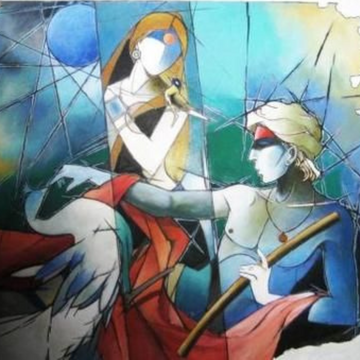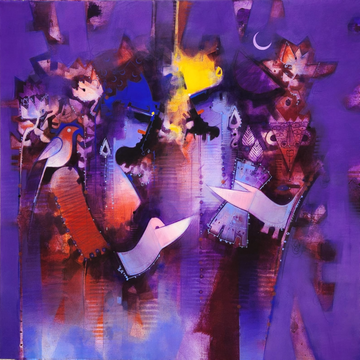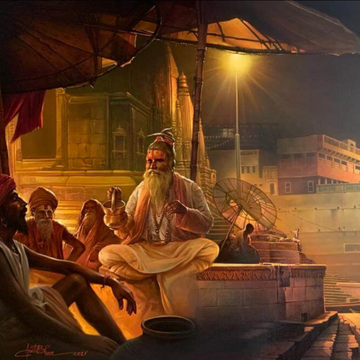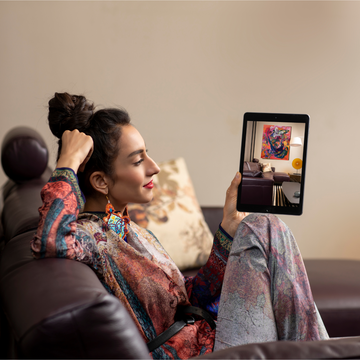The Italian Renaissance Trail and Some Masterpieces: The Louvre
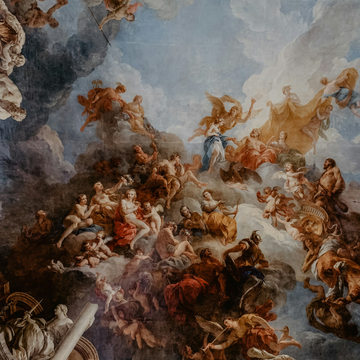
Paris is that messy menagerie where art movements spanning centuries have sought harbour, and till date it remains one of those very few cities that seem to have captured the essence of Renaissance. It then comes as no surprise that the French Renaissance movement was inspired largely by the Italian Renaissance.
By the end of the fifteenth century, Paris adopted the symmetry and style of Renaissance architecture, before it began developing its own distinct style—paving the way from the cluttered and unplanned medieval era. This organization and coherence can possibly be briefly glimpsed as you walk down the Louvre – in its formidable collection of the Old Italian Masters. No journey that focuses on the unadulterated appreciation of art can begin without a mention of Louvre’s Grand Gallery that has brought together the celebrated da Vinci, Raphael and Caravaggio among others.
In this article, we have attempted to showcase selected masterpieces hung in the galleries of the Louvre in a chronological manner. It not only provides the viewer an idea on how to navigate through the maze, but also understand each work in its broader context: the political, cultural, and economic circumstances that birthed it. It is also perhaps the best way to identify how one generation of art influenced the next, while forming its own unique identity.
In Search of the Old Masters
Let us attempt a walk-through of the museum’s Italian section, taking in both known and oft-overlooked masterpieces, charting a mostly chronological movement from Early to High Renaissance. Like all other art movements, Renaissance art was informed and shaped by Italy’s presiding political climate – the development of the arts quickly escalated into a quest to establish supremacy of one’s patron. This competitive patronage perhaps birthed the all-round artist – one who was everything, a painter, poet, architect, philosopher and scientist. It is at this note that we turn towards the Louvre’s Denon wing, having made our way past the Winged Victory of Samothrace (or, Nike of Samothrace – a surviving piece of Hellenistic art symbolizing all that influenced the Renaissance).

Giotto
We are first encountered by the Florentine artist Giotto’s famed altarpiece – St. Francis of Assisi Receiving the Stigmata(1300).

Mentioned first by Georgio Vasari, the work was acquired by the Louvre in the year 1813. An observer would first notice the striking use of chiaroscuro – a technique depicting the play of light and shadows, taken to its pinnacle by the likes of Caravaggio and Rembrandt. The scene moves away from the older era of ‘unemotional’, serene frontal figures and flat ornamental landscapes to depict an underlying sense of disquiet amid semi-proportional surroundings. The work, so to speak, encapsulates the huge strides that the Renaissance took in breaking away from Byzantine traditions to capture the earthly, the human, and the natural. The focus shifts from religion to the individual – and here is that tiny shift of thought, the harbinger of Humanism. Look closely at the palpable sense of fear on St. Francis’ face as he experiences the miracle, framed by darkness and light. His body sways in prayer and devotion. St. Francis embodies the earthly, a stark contrast to the comparatively diminutive figure of the winged Christ ascending from Heaven.
Fra Angelico
Now our gaze shifts towards The Coronation of the Virgin by Fra Angelico, a study in perspective and the use of space to represent human figures. Set in paradise – the Virgin Mary is being crowned by Christ, the painting eschews any desire to represent heaven as ‘otherworldly’. While the intensity of light that imbues the space is remarkable, the work is strikingly realistic and expressive.

Paolo Uccello
The Great Gallery, or Room 5, houses another Master’s seminal work, Paolo Uccello’s The Battle of San Romano.

The final panel, that is, one of the three versions hangs in the Louvre. It depicts Niccolo aiding the Florentine mercenary, Michelotto da Cotignola, as they counterattack the Sienese across the Arno river. The series is essentially that of military feats – a kind of propaganda, if you will. Hence, the painting does not really espouse realism: instead, it is a detailed study of strong, visual decorative elements – the horses, the uniforms. His style is that of conjuring a narrative, with an unnatural obsession with perspective – everything is reduced mathematically to its proportionate size.
Mantegna
Next, we move on to Mantegna’s St Sebastian. Observe the painstaking realism of the body, recalling the classical Greek sculptures, such a marked departure from the almost-wooden depictions in the Early Renaissance period. This piece squarely faces the importance on the human figure and not on space – a style that holds prominence is all subsequent generations of art.

Botticelli
Consider for example, Room 4, where hangs The Allegory of the Liberal Arts by Sandro Botticelli.

Botticelli was known for his luminescent, voluptuous figures, and his fresco is an early indicator of this. Instead of muscular strength or energy, his figures are naturally imbued with a sense of calm; they are rounded and soft, melancholy and thoughtful. This particular piece depicts a young man, one guesses this is Lorenzo Tornabuoni, led by a ‘Grammar’ into a circle of allegorical figures representing the Seven Liberal Arts (Prudence, Rhetoric, Logic, Arithmetic, Geometry, Astronomy and Music) – all deemed essential in fulfilling a true education.
Famous Portraits – From Francesca to Raphael
Next in line hangs a series of famed portraits: Piero della Francesca’s portrait of Sigismondo Malatesta (notable for its distinct Flemish influence – document the distinctive features, the sharpness of the lines around the nose, the mouth and the chin, the stern gaze of the eyes and the gold-embroidered jacket):

Antonello da Messina's Portrait of a Man (an early example of the painter’s mastery over oil as a medium – highlighting even the faintest of glimmers in the subject’s eyes):

Leonardo da Vinci’s St. John the Baptist (an androgynous, mysterious figure turning in the ‘light’ – his body bathed in shadows):

And finally, the most famous of them all, Mona Lisa.
The Louvre tags the Portrait of Lisa Gherardini (Mona Lisa) as the world’s most celebrated painting, and the title is quite befitting.

It is estimated that over 6 million people visit the Mona Lisa each year at the Louvre. Encased in bullet-proof glass, this painting has achieved cult status, even among those who are not art aficionados. It was painted for Francesco del Giocondo and is a portrait of his wife. and was possibly commissioned to mark either of two events – purchasing a house in 1503 or the birth of the family's second son in 1502. But what is really arresting about the portrait is not the story about how it came about, it is the narrative conjured by the composition, the colour palette and the technique employed. Seated on a balcony, the subject divides the landscape beyond her: one part is civilized, and the other half imaginary. Her hair is partly covered by what appears to be a mourning veil, and the years of varnished has made the portrait darker, duller, and probably contributed to its mystery. Leonardo’s use of sfumato, a technique that is quite akin to the modern digital ‘blur’ tool, blends all sharp edges, blends the light with the dark, adding an incredible sense of depth. It is perhaps most difficult to assess the subject’s mood, but the landscape surely represents happiness. Note the distant winding road and the bridge in the civilized background, the rocks and water of the pristine wild bit – everything bathed in warm tones and light – the effect is almost atmospheric. Yet the corners of her mouth are shadowed, making that smile elusive for ever.
The next stop is at Raphael’s portrait of Baldassare Castiglione – and here you can see traces of Mona Lisa: the posture, the gaze and the lovely play of light. The portrait, one of the most celebrated in western painting, depicts the diplomat and humanist Baldassare Castiglione, one of the brightest in the courtly circles. One notices the soft contours of his clothes, the fabric, yet does not miss his grace or intelligence.

Raphael was indeed an undisputed master of the High Renaissance period, his fame furthered by his Madonnas. His figures are sedate, his compositions verging on lyrical, and his chiaroscuro appears to flesh out his subjects within the painting. However, unlike da Vinci, Raphael used a much lighter palette, creating works that embody harmony and peace. This brings us to St. Michael Vanquishing Satan, another of Raphael’s works that hangs in the Louvre (Room 6) – a perfect example of his evolved style. His trademarked style of intersecting triangles, dramatic lighting, and dramatic gestures are all seen in this particular painting.

The Last Leg: Titian, Veronese, Tintoretto and Lotto
Now we enter the final phase of this trail. Here hangs Titian’s The Pastoral Concert.

It has been one of the more influential paintings in the museum, particularly on nineteenth-century painters. The subject is in all probability allegorical, we see a man in noblemen’s robes, a shepherd, a peasant and two nude nymphs. Perhaps it is a painterly discourse on the matters of love, music and the pastoral. The next painting by Titian is Biblical: The Entombment of Christ.

The landscape her differs considerably from The Pastoral Concert – a low horizon, with a dimming sun. Again, the painting stands for something larger than what has been portrayed; it appears to be ruminating on life and death – the pallor of Christ forms a striking contrast against the sheer muscular strength of the men carrying him.
Veronese’s The Wedding Feast at Cana and Portrait of a Venetian Woman hang side by side, right opposite the Mona Lisa.


Veronese influenced painters such as Delacroix and Renoir, with his large canvases and striking use of rich colours. For him, it is all about the magnificence of the larger spectacle.
Tintoretto’s Coronation of the Virgin is a composition of immense scope.

Like Veronese and his large-format narratives – Tintoretto believe in creating a spectacle, and this painting captures his grand vision of Paradise in perfect, symmetrical circles. The painter specialized in large-scale religious narrative scenes, and his style is identifiable with its exaggerated and dramatic use of perspective and foreshortening, and unique, sketchy brushwork.
The last painting, by Lorenzo Lotto, is of Christ Carrying the Cross.

The style resembles that of Early Netherlandish master Hieronymous Bosch – the faces of his tormentors are distorted, in their mockery, they themselves have become caricatures in the hands of the artist. While all else recedes to the background, the figure of Christ becomes clearer as the sufferer. We have moved beyond the mystery of da Vinci and the harmony of Raphael – with Lotto, we enter perhaps a new phase of art that sought to evoke raw human emotion.
Information:
The Louvre offers a number of informative Visitor Trails. If interested, you could sign up for the Italian Renaissance Painting trail:
Length: 1 hr 30 mins
Tour days: Monday Wednesday Thursday Friday Saturday Sunday
If you are mostly interested in looking at the masterpieces, you can opt for the Masterpieces, Accessible Visitor Trail:
Length: 1 hr 30 mins
Tour days: Monday Wednesday Thursday Friday Saturday Sunday
Hours and Admission: Open every day except Tuesday
Monday, Thursday, Saturday, Sunday: from 9 a.m. to 6 p.m.
Wednesday, Friday: from 9 a.m. to 9:45 p.m.
Closed on Tuesdays
Rooms begin closing 30 minutes before museum closing time.
Tickets bought at the museum: €15
Tickets valid for a same-day visit to the Louvre (permanent collections and temporary exhibitions) and the Musée Eugène-Delacroix.
Note: Every Friday from 6 p.m. admission to the museum is free for under-26s of all nationalities on presentation of valid ID.
From October to March, admission to the museum is free for all visitors on the first Sunday of each month.


